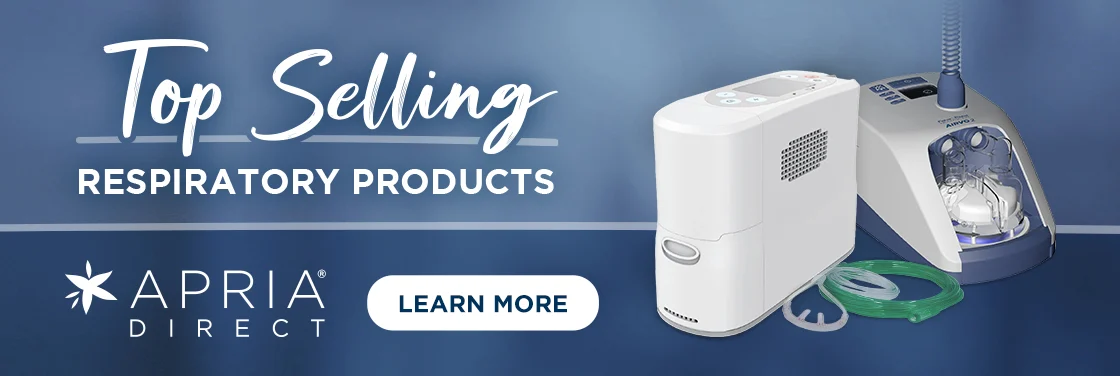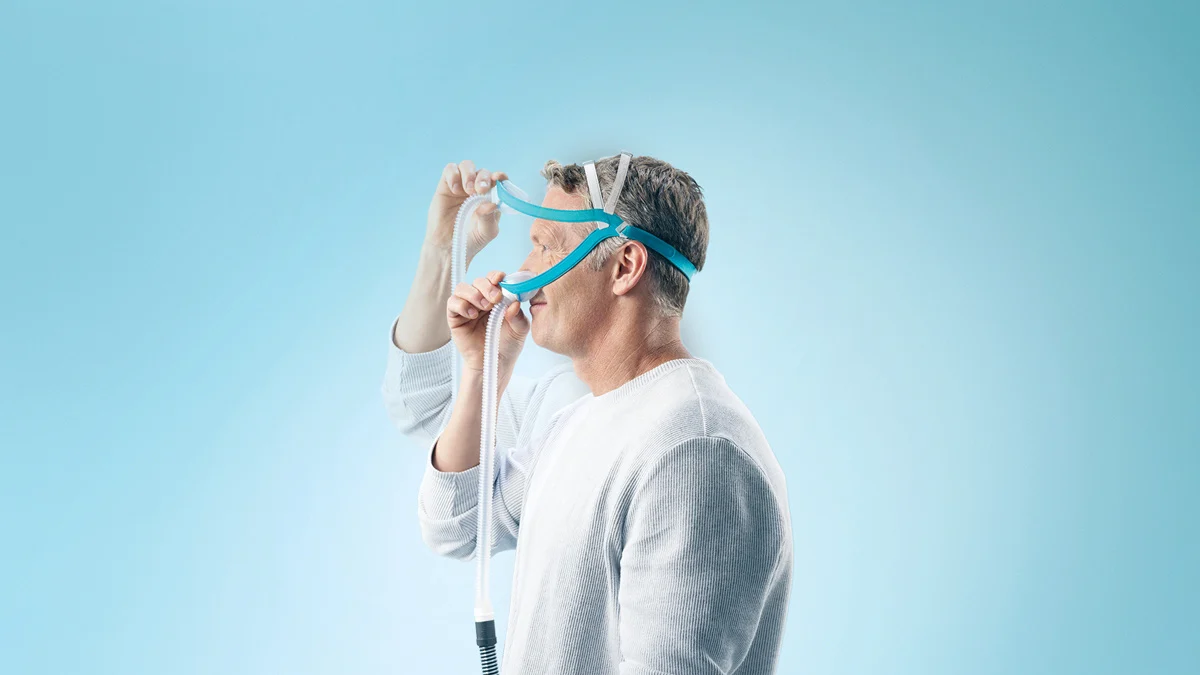Low Oxygen Levels Increase Your Chances of Waking Up With a Headache. Here’s What You Can Do!
Everyone gets a headache now and then, whether it’s due to exercising too hard or partying too late into the night. But for people with COPD (chronic obstructive pulmonary disease), morning headaches are all too common.
People describe COPD headaches as dull and throbbing. In some cases, they can be quite severe and significantly affect quality of life.
COPD headaches occur most often when we have a low blood oxygen level, which is a symptom of COPD.
Lesley Williams, Apria’s Market Clinical Trainer and a registered respiratory therapist, says, “The good news: there are proven methods to help relieve and prevent COPD headaches from occurring.”
What Causes COPD Headaches?
When we inhale, air enters our lungs. Our bodies take the oxygen from the air and move it into our blood, where it is distributed throughout our body.
Then, carbon dioxide, a waste gas, moves from our blood to the lungs and is exhaled.
For people with COPD, the lungs are often damaged or clogged with phlegm. This makes it harder to inhale oxygen and exhale carbon dioxide.
This results in a condition called hypoxia, where your body doesn’t have enough oxygen. And hypercapnia, where your body has too much carbon dioxide.
This build-up of carbon dioxide in your blood reaches your brain. Because the brain craves oxygen, it dilates blood vessels, which pushes on nearby nerves and causes COPD headaches.
Who Is at Risk for COPD Headaches?
All people with COPD are at risk for developing headaches. Morning headaches tend to occur more often for people with COPD who:
- Are in a later stage of COPD
- Have sleep apnea: a sleeping disorder where your breathing starts and stops throughout the night. People with COPD often have sleep apnea
- Receive oxygen therapy during the night. This can be resolved by having your doctor adjust your oxygen therapy—more on this shortly!
Here are 9 tips to prevent and treat COPD headaches.
1. Use Oxygen Therapy
To replace the oxygen your body needs, doctors prescribe oxygen therapy. It is commonly delivered through tubes inserted into both nostrils or via a face mask.
Oxygen tanks have been used for years to provide therapy. But they tend to be big and bulky. Portable oxygen concentrators may be a smaller, lighter option.
2. Treat Sleep Apnea with CPAP
CPAP (continuous positive airway pressure) has been used for decades to treat sleep apnea.
With CPAP, you wear a mask over your nose or mouth. The mask is connected to a machine that delivers a constant, quiet flow of pressurized air to keep your breathing passages open to ensure normal breathing and better sleep.
3. Take Your Prescribed Medications
Talk with your doctor about the following medications that can effectively treat COPD headaches:
- Bronchodilators: inhaled medications that relax your bronchial muscles and expand your airways to help get more oxygen into your body
- Oral steroids: available in pill or liquid form to treat COPD flare-ups (also called exacerbations). Oral steroids are fast-acting; they’re usually prescribed for short-term use (about 5-7 days)
- Inhaled steroids: these deliver medication directly into your lungs. Inhaled steroids are used as a “maintenance medication” for people whose symptoms are stable
4. Try OTC Meds
Over-the-counter (OTC) pain medications can help relieve COPD headaches. However, over time your body can become immune to the effects of the medication, resulting in liver and kidney problems.
Healthcare professionals recommend taking OTC meds no more than twice a week and not over prolonged periods. Speak with your doctor before starting any OTC pain meds.
5. Change Your Sleeping Position
For people with COPD, lying on their back makes breathing more difficult and can cause COPD headaches. Try sleeping on your side, which should help you breathe—and sleep—more easily throughout the night.
6. Keep Your Head Up
When you go to bed, use firm pillows to prop your head up, which will help open your airways and improve your sleep.
7. Eat a COPD-Friendly Diet
Your diet plays an important role in reducing your risk for COPD headaches. Your meals should include:
- Protein: fish, eggs, lean meat
- Fiber: vegetables, nuts, fruits
- Unsaturated fats: canola oil, corn oil
But try to avoid the following:
- Trans and saturated fat: fried food, butter, skin of meat
- Simple carbohydrates: sugar, candy, soft drinks, cake
- Foods that cause gas: beans, broccoli, fizzy drinks
- Salty foods: cured meats and fish, frozen dinners
Also, refrain from foods that increase mucus, such as coffee, tea, chocolate, and carbonated beverages—especially before bedtime. Excess mucus in your lungs makes breathing more difficult.
8. Exercise Often
Exercising regularly keeps your lungs healthy so they can deliver the oxygen you need as you sleep. Plus, keeping active improves your overall strength and well-being. Speak with your healthcare professional about creating an exercise routine that’s just right for you.
9. Stop Smoking!
Research reveals that smoking is one of the biggest culprits behind COPD headaches. Cigarette smoke also causes obstruction and inflammation of your lungs, making your COPD worse.
If you still smoke, stop. No ifs, ands, or BUTTS!
Head Off COPD Headaches!
If COPD is giving you a headache, try the 9 tips discussed in this article. Apria’s Lesley Williams advises, “If headaches persist, they may be caused by a health condition other than COPD. Speak with your doctor so you can get the right treatment.”
References
1. Cherney, K. (Updated 2018, November 5). Managing COPD Headaches. Healthline. https://www.healthline.com/health/copd/headache.
2. Minen MT, Weissman J, Tietjen GE. The Relationship Between Migraine or Severe Headache and Chronic Health Conditions: A Cross-Sectional Study from the National Health Interview Survey 2013–2015. Pain Med. 2019 Nov; 20(11): 2263–2271.
3. Editorial Team. (2017, June). Morning Headaches. COPD.net. https://copd.net/symptoms/morning-headaches.
4. Roland, J. (Updated 2018, November 7). Steroids for COPD. Healthline. https://www.healthline.com/health/copd/steroids.
5. Ragland, L. (2022, June 27). Sleep Tips for People With COPD.
WebMD. https://www.webmd.com/lung/copd/copd-sleep-tips.
6. Millard, E. (Updated 2022, January 5). 5 Tips for Actually Sleeping With COPD. Health Central. https://www.healthcentral.com/slideshow/5-tips-for-getting-restful-sleep-with-copd.
7. WebMD Editorial Contributors. (2022, September 14). Headache Basics. WebMD. https://www.webmd.com/migraines-headaches/migraines-headaches-basics.
LEGAL DISCLAIMER: Material in this newsletter is provided for general health education and informational purposes and to provide references to other resources only; it may not apply to you as an individual. While Apria Healthcare believes that the information provided through this communication is accurate and reliable, Apria Healthcare cannot and does not make any such guarantee. It is not intended to be a replacement for professional medical advice, evaluation, diagnosis, services or treatment (collectively, “medical treatment”). Please see your healthcare provider for medical treatment related to you and your specific health condition(s). Never disregard medical advice or delay seeking medical care because of something you have read on or accessed through this website. Reading this newsletter should not be construed to mean that you have a healthcare provider/patient relationship.


.png)



